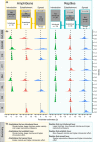Fast life history traits promote invasion success in amphibians and reptiles
- PMID: 28052550
- PMCID: PMC6849728
- DOI: 10.1111/ele.12728
Fast life history traits promote invasion success in amphibians and reptiles
Abstract
Competing theoretical models make different predictions on which life history strategies facilitate growth of small populations. While 'fast' strategies allow for rapid increase in population size and limit vulnerability to stochastic events, 'slow' strategies and bet-hedging may reduce variance in vital rates in response to stochasticity. We test these predictions using biological invasions since founder alien populations start small, compiling the largest dataset yet of global herpetological introductions and life history traits. Using state-of-the-art phylogenetic comparative methods, we show that successful invaders have fast traits, such as large and frequent clutches, at both establishment and spread stages. These results, together with recent findings in mammals and plants, support 'fast advantage' models and the importance of high potential population growth rate. Conversely, successful alien birds are bet-hedgers. We propose that transient population dynamics and differences in longevity and behavioural flexibility can help reconcile apparently contrasting results across terrestrial vertebrate classes.
Keywords: Amphibians; biological invasions; comparative analyses; invasion biology; invasive species; life history theory; population dynamics; population growth; reptiles; transient dynamics.
© 2017 The Authors. Ecology Letters published by CNRS and John Wiley & Sons Ltd.
Figures


References
-
- Allen, C.R. , Nemec, K.T. , Wardwell, D.A. , Hoffman, J.D. , Brust, M. , Decker, K.L. et al (2013). Predictors of regional establishment success and spread of introduced non‐indigenous vertebrates. Glob. Ecol. Biogeogr., 22, 889–899.
-
- Blackburn, T.M. , Pyšek, P. , Bacher, S. , Carlton, J.T. , Duncan, R.P. , Jarošík, V. et al (2011). A proposed unified framework for biological invasions. Trends Ecol. Evol., 26, 333–339. - PubMed
-
- Blackburn, T.M. , Lockwood, J.L. & Cassey, P. (2015). The influence of numbers on invasion success. Mol. Ecol., 24, 1942–1953. - PubMed
Publication types
MeSH terms
Associated data
LinkOut - more resources
Full Text Sources
Other Literature Sources

